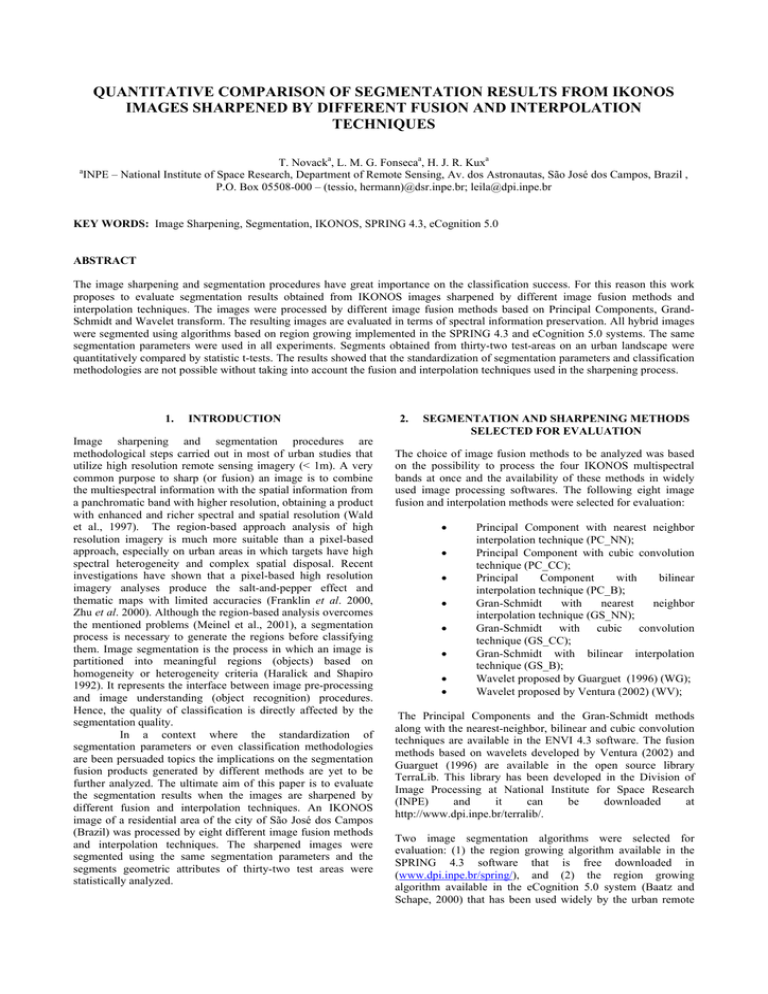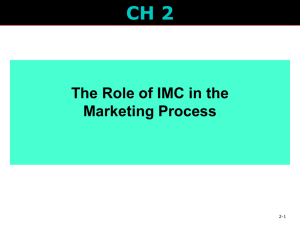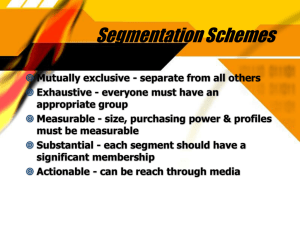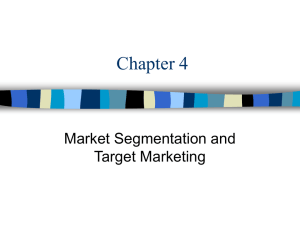QUANTITATIVE COMPARISON OF SEGMENTATION RESULTS FROM IKONOS
advertisement

QUANTITATIVE COMPARISON OF SEGMENTATION RESULTS FROM IKONOS
IMAGES SHARPENED BY DIFFERENT FUSION AND INTERPOLATION
TECHNIQUES
T. Novacka, L. M. G. Fonsecaa, H. J. R. Kuxa
INPE – National Institute of Space Research, Department of Remote Sensing, Av. dos Astronautas, São José dos Campos, Brazil ,
P.O. Box 05508-000 – (tessio, hermann)@dsr.inpe.br; leila@dpi.inpe.br
a
KEY WORDS: Image Sharpening, Segmentation, IKONOS, SPRING 4.3, eCognition 5.0
ABSTRACT
The image sharpening and segmentation procedures have great importance on the classification success. For this reason this work
proposes to evaluate segmentation results obtained from IKONOS images sharpened by different image fusion methods and
interpolation techniques. The images were processed by different image fusion methods based on Principal Components, GrandSchmidt and Wavelet transform. The resulting images are evaluated in terms of spectral information preservation. All hybrid images
were segmented using algorithms based on region growing implemented in the SPRING 4.3 and eCognition 5.0 systems. The same
segmentation parameters were used in all experiments. Segments obtained from thirty-two test-areas on an urban landscape were
quantitatively compared by statistic t-tests. The results showed that the standardization of segmentation parameters and classification
methodologies are not possible without taking into account the fusion and interpolation techniques used in the sharpening process.
1.
INTRODUCTION
Image sharpening and segmentation procedures are
methodological steps carried out in most of urban studies that
utilize high resolution remote sensing imagery (< 1m). A very
common purpose to sharp (or fusion) an image is to combine
the multiespectral information with the spatial information from
a panchromatic band with higher resolution, obtaining a product
with enhanced and richer spectral and spatial resolution (Wald
et al., 1997). The region-based approach analysis of high
resolution imagery is much more suitable than a pixel-based
approach, especially on urban areas in which targets have high
spectral heterogeneity and complex spatial disposal. Recent
investigations have shown that a pixel-based high resolution
imagery analyses produce the salt-and-pepper effect and
thematic maps with limited accuracies (Franklin et al. 2000,
Zhu et al. 2000). Although the region-based analysis overcomes
the mentioned problems (Meinel et al., 2001), a segmentation
process is necessary to generate the regions before classifying
them. Image segmentation is the process in which an image is
partitioned into meaningful regions (objects) based on
homogeneity or heterogeneity criteria (Haralick and Shapiro
1992). It represents the interface between image pre-processing
and image understanding (object recognition) procedures.
Hence, the quality of classification is directly affected by the
segmentation quality.
In a context where the standardization of
segmentation parameters or even classification methodologies
are been persuaded topics the implications on the segmentation
fusion products generated by different methods are yet to be
further analyzed. The ultimate aim of this paper is to evaluate
the segmentation results when the images are sharpened by
different fusion and interpolation techniques. An IKONOS
image of a residential area of the city of São José dos Campos
(Brazil) was processed by eight different image fusion methods
and interpolation techniques. The sharpened images were
segmented using the same segmentation parameters and the
segments geometric attributes of thirty-two test areas were
statistically analyzed.
2.
SEGMENTATION AND SHARPENING METHODS
SELECTED FOR EVALUATION
The choice of image fusion methods to be analyzed was based
on the possibility to process the four IKONOS multispectral
bands at once and the availability of these methods in widely
used image processing softwares. The following eight image
fusion and interpolation methods were selected for evaluation:
•
•
•
•
•
•
•
•
Principal Component with nearest neighbor
interpolation technique (PC_NN);
Principal Component with cubic convolution
technique (PC_CC);
Principal
Component
with
bilinear
interpolation technique (PC_B);
Gran-Schmidt
with
nearest
neighbor
interpolation technique (GS_NN);
Gran-Schmidt with cubic convolution
technique (GS_CC);
Gran-Schmidt with bilinear interpolation
technique (GS_B);
Wavelet proposed by Guarguet (1996) (WG);
Wavelet proposed by Ventura (2002) (WV);
The Principal Components and the Gran-Schmidt methods
along with the nearest-neighbor, bilinear and cubic convolution
techniques are available in the ENVI 4.3 software. The fusion
methods based on wavelets developed by Ventura (2002) and
Guarguet (1996) are available in the open source library
TerraLib. This library has been developed in the Division of
Image Processing at National Institute for Space Research
(INPE)
and
it
can
be
downloaded
at
http://www.dpi.inpe.br/terralib/.
Two image segmentation algorithms were selected for
evaluation: (1) the region growing algorithm available in the
SPRING 4.3 software that is free downloaded in
(www.dpi.inpe.br/spring/), and (2) the region growing
algorithm available in the eCognition 5.0 system (Baatz and
Schape, 2000) that has been used widely by the urban remote
sensing researchers community. These two segmentation
algorithms were well evaluated by Meinel and Neubert (2004)
and were considered the best ones.
3.
α original , sharpened =
STUDY AREA
The study area is delimited by coordinates 407395W, 7433715S
and 408329W, 7434623S at spatial reference UTM/WGS84,
zone 23 at southern hemisphere. This is mainly a high standard
residential area of São José dos Campos city (Figure 1). Most of
the houses in this area have ceramic tile roofs, swimming pools
and grass gardens.
Λ original , sharpened
2
2
σ original
σ sharpened
(2)
where Λ original, sharpened = the covariance among the original
and the sharpened image of a given band
σ 2 = the standard deviation of the image of a given
band.
The best fusion method was the Principal Components with the
nearest-neighbor interpolation technique (PC NN), which
showed the correlation index closer to one and the Bias closest
to zero (Table 1). The segments obtained using the sharpened
image processed by PC NN method were compared with the
segments obtained by the other fusion methods.
Band
B1
B2
B3
B4
Figure 1. Study area and its location on the municipality of São
José dos Campos
4.
B1
B2
B3
B4
METHODOLOGY
To evaluate the influence of different image sharpening
methods on the segmentation results the following processing
steps were preceded: (1) processing IKONOS images by
different methods and interpolation techniques; (2) evaluating
the hybrid images in terms of spectral information preservation;
(3) selecting the best fusion method as the reference method; (4)
normalizing the mean and standard deviation values of the
sharpened images conform to the reference one; (5) segmenting
the images using the same segmentation parameters using both
segmentation algorithms mentioned before; (6) calculating the
objects geometric measurements for thirty-two test areas, and
(7) evaluating the segmentation results.
4.1. Measures for evaluating the sharpened images
The purpose of this step is to find out the best fusion method in
terms of spectral information preservation. This method is taken
as the reference method. Two measures to evaluate the spectral
information preservation were used: BIAS and Correlation
Index.
BIAS value calculates the difference between the mean values
of the original and sharpened images (ideal case equals zero) :
μ ORIGINAL − μ SHARPENED
where μ ORIGINAL and
μ SHARPENED
(1)
are the mean values of
the original and sharpened images, respectively.
The Correlation Index between the original and sharpened
images (ideal case equals one) is given by:
B1
B2
B3
B4
B1
B2
B3
B4
B1
B2
B3
B4
B1
B2
B3
B4
B1
B2
B3
B4
B1
BIAS
PC NN
-9.143972
-6.674768
-4.355432
1.425276
PC CC
-9.689009
-6.676587
-3.985717
1.57718
PC B
-10.528807
-6.933944
-4.133351
1.699402
GS NN
-10.114095
-7.177298
-3.396238
0.685108
GS CC
-10.732204
-7.880836
-3.701562
0.841488
GS B
-12.5835
-8.755472
-4.407556
0.964452
WV
-10.229806
8.703358
25.062016
37.785912
WG
-10.280569
Corr. Index
0.676965
0.65278
0.675711
0.648594
0.657142
0.646359
0.665506
0.597472
0.664186
0.64926
0.667237
0.608837
0.669505
0.652454
0.6801
0.628953
0.653719
0.645531
0.667523
0.60058
0.654083
0.643645
0.664676
0.614272
0.433221
0.482646
0.555849
0.432773
0.389587
B2
B3
B4
8.605182
24.831315
37.720533
0.444547
0.515722
0.415833
H0 : βn = X
H α : βn ≠ X
The decision rule for these statistic tests when controlling the
level of significance at α is:
Table 1. Quantitative evaluation of the image sharpening
methods by the measures Bias and Correlation Index
4.2. Measures for evaluating the segmented images
If t * ≤ t (1 − α / 2; n − 2 ) , conclude H0
There is a large variety of quantitative segmentation evaluation
approaches proposed in the literature (Estrada and Jepson, 2005;
Hirschmugl, 2002; Schukraft and Lenz, 2003; Zhang et al.,
2004). In this study, geometric attributes such as area (Ai),
perimeter (Pi) and Shape Index (SHi) were used in the
segmentation evaluation similar to the procedure proposed by
Neubert and Meinel (2003; 2004). The Shape Index (3) comes
from landscape ecology and addresses the polygon form.
If t * > t (1 − α / 2; n − 2 ) , conclude H α .
SH i =
Pi
.
(3)
4 Ai
5.
The t statistics were calculated for three measures for each of
the seven segmentations obtained from images sharpened by
seven different methods. This was performed for segmentations
obtained using SPRING 4.3 (Table 2) and eCognition 5.0
softwares (Table 3). Three levels of confidence were
considered: 99%, 95% and 90%. The lower the level of
confidence the more robust the test is.
*Mt
4.3. Measures for evaluating the segmented images
After calculating the geometric attributes for thirty-two test
areas, statistical tests were conducted to evaluate whether or not
segments generated from sharpened images were significantly
different in relation to the reference segments (those obtained
from image sharpened by reference fusion method).
Simple linear regressions were applied, considering as
dependent variable (Y) the geometric attributes of the reference
segments. On the other hand, geometric attributes of the
segments generated from images sharpened by the other seven
methods were taken as independent variable (X). This
procedure was performed for both segmentation algorithms
(SPRING 4.3 and eCognition 5.0). If the segments of the
images processed by different fusion methods were equal, then
the linear regression coefficients would assume the following
values: β 0 = 0 , β 1 = 1 and β 1 ≠ 0 . Tests concerning
CC
B
Ai
GS
NN
the t distribution. To test whether β 0 = 0 the statistics
B
Ai
Ai
(4)
GS
were calculated and to test whether β 1 ≠ 0 the statistics
b
t* = 1
s{b1 }
Ai
PC
GS
b0
s{b0 }
*Ms
PC
coefficients β 0 and β 1 can be set up in ordinary fashion using
t* =
CC
Ai
(5)
WV
Ai
were calculated. To test whether β 1 = 1 the statistics
t* =
b1 − 1
s{b1 }
(6)
were calculated. Where b1 is the inclination coefficient of the
fitted regression line and s{b1} is an unbiased estimator of the
RESULTS
WG
Ai
PC
CC
Pi
standard error of b1 .
For the three tests the two alternative hypotheses are:
PC
Pi
Test
β0 = 0
β1 ≠ 0
β1 = 1
β0 = 0
β1 ≠ 0
β1 = 1
β0 = 0
β1 ≠ 0
β1 = 1
β0 = 0
β1 ≠ 0
β1 = 1
β0 = 0
β1 ≠ 0
β1 = 1
β0 = 0
β1 ≠ 0
β1 = 1
β0 = 0
β1 ≠ 0
β1 = 1
β0 = 0
β1 ≠ 0
β1 = 1
β0 = 0
1- α
Stat t
99%
95%
90%
0.44
H0
H0
H0
7.67
Ha
Ha
Ha
0.69
H0
H0
H0
2.03
H0
H0
H0
12.5
Ha
Ha
Ha
1.84
H0
Ha
Ha
0.79
H0
H0
H0
5.54
Ha
Ha
Ha
1.58
H0
H0
Ha
0.20
H0
H0
H0
4.91
Ha
Ha
Ha
1.63
H0
H0
Ha
0.95
H0
H0
H0
8.22
Ha
Ha
Ha
0.13
H0
H0
H0
1.68
H0
H0
Ha
2.05
H0
Ha
Ha
3.26
Ha
Ha
Ha
0.63
H0
H0
H0
4.81
Ha
Ha
Ha
0.33
H0
H0
H0
0.01
H0
H0
H0
6.98
Ha
Ha
Ha
0.58
H0
H0
H0
1.36
H0
H0
Ha
B
GS
NN
Pi
GS
B
Pi
GS
CC
WV
WG
Pi
Pi
Pi
PC
CC
SHi
PC
B
SHi
GS
NN
SHi
GS
B
SHi
GS
CC
WV
WG
SHi
SHi
SHi
β1 ≠ 0
β1 = 1
β0 = 0
β1 ≠ 0
β1 = 1
β0 = 0
β1 ≠ 0
β1 = 1
β0 = 0
β1 ≠ 0
β1 = 1
β0 = 0
β1 ≠ 0
β1 = 1
β0 = 0
β1 ≠ 0
β1 = 1
β0 = 0
β1 ≠ 0
β1 = 1
β0 = 0
β1 ≠ 0
β1 = 1
β0 = 0
β1 ≠ 0
β1 = 1
β0 = 0
β1 ≠ 0
β1 = 1
β0 = 0
β1 ≠ 0
β1 = 1
β0 = 0
β1 ≠ 0
β1 = 1
β0 = 0
β1 ≠ 0
β1 = 1
8.92
Ha
Ha
Ha
1.13
H0
H0
H0
0.60
H0
H0
H0
3.07
Ha
Ha
Ha
0.34
H0
H0
H0
0.88
H0
H0
H0
4.45
Ha
Ha
Ha
2.61
Ha
Ha
Ha
0.00
H0
H0
H0
6.34
Ha
Ha
Ha
1.43
H0
H0
Ha
2.47
Ha
Ha
Ha
1.39
H0
H0
Ha
3.86
Ha
Ha
Ha
1.94
H0
Ha
Ha
2.50
Ha
Ha
Ha
2.98
Ha
Ha
Ha
1.54
H0
H0
Ha
6.46
Ha
Ha
Ha
2.39
H0
Ha
Ha
0.86
H0
H0
H0
5.38
Ha
Ha
Ha
1.30
H0
H0
H0
1.70
H0
Ha
Ha
3.48
Ha
Ha
Ha
1.66
H0
H0
Ha
2.34
H0
Ha
Ha
4.52
Ha
Ha
Ha
3.22
Ha
Ha
Ha
1.89
H0
Ha
Ha
5.59
Ha
Ha
Ha
2.96
Ha
Ha
Ha
2.90
Ha
Ha
Ha
1.91
H0
Ha
Ha
3.10
Ha
Ha
Ha
12.4
Ha
Ha
Ha
0.19
H0
H0
H0
198
Ha
Ha
Ha
In the case that segmentation results are equal, we would expect
conclusion H0 for the tests β 0 = 0 , β 1 = 1 and H α for the
test β 1 ≠ 0 . This means that the regression line passes through
the origin with an angle of 45o. For the confidence level of 99%,
the fusion methods whose segments were equal to those
obtained from images sharpened by PC_NN method were
PC_CC, PC_B and GS_NN. In these cases, the images were
segmented using the segmentation algorithm implemented in
the SPRING system. In relation to the geometric attribute Ai
only the method WV did not present segments equal to those of
the reference segments. For the geometric attribute Pi, methods
GS_B, WG and WV are statistically different from the
reference segments. For the geometric attribute SHi only
PC_CC, PC_B and GS_NN are equal to the reference segments.
At the confidence level of 95% none of the segmentation results
generated using SPRING system obtained segments equal to the
reference segments for the three attributes. Segments obtained
from images sharpened by methods PC_B and WV were only
those whose attributes Ai are statistically different from the
reference segments. As for attribute Pi, methods GS_B, WG and
WV are statistically different from the reference segments just
as like at confidence level of 99%. For attribute SHi, segments
obtained from image sharpened by PC_B are statistically equal
to the reference segments at confidence levels of 95% and 90%.
Segments obtained from images sharpened by methods PC_CC,
GS_CC and WG have values of Ai equal to those of the
reference segments at confidence level of 90%. As for attribute
Pi, methods PC_CC and GS_NN are only ones whose segments
are statistically equal to the reference segments.
Surprising is the fact that none of the segments
generated by eCognition system are statistically equal to the
reference segments at all of the confidence levels. In lots of
cases not even a linear statistical association between the
measures calculated for the reference segments and the others
could be assumed. In the linear regression tests β 0 = 0
and β 1 = 1 the majority of the cases assumed H α for
segmentations generated in the eCognition system. The only
exception is for segments obtained from images sharpened by
method GS_B at confidence level of 99% (Table 3).
*Mt
*Ms
Test
Ai
β0 = 0
β1 ≠ 0
Ai
β1 = 1
β0 = 0
β1 ≠ 0
Ai
β1 = 1
β0 = 0
β1 ≠ 0
Ai
β1 = 1
β0 = 0
β1 ≠ 0
PC
CC
PC
B
GS
NN
GS
Table 2. T-tests performed for segmentations in the SPRING
4.3 system. *Mt and Ms stand for method and measure,
respectively
CC
GS
β1 = 1
β0 = 0
Ai
1- α
Stat t
99%
95%
90%
2.72
Ha
Ha
Ha
1.95
H0
Ha
Ha
3.30
Ha
Ha
Ha
3.90
Ha
Ha
Ha
3.69
Ha
Ha
Ha
5.32
Ha
Ha
Ha
3.70
Ha
Ha
Ha
2.41
H0
Ha
Ha
3.85
Ha
Ha
Ha
2.52
Ha
Ha
Ha
3.20
Ha
Ha
Ha
Ha
Ha
Ha
Ha
Ha
Ha
2.62
4.58
Pi
β1 ≠ 0
β1 = 1
β0 = 0
β1 ≠ 0
β1 = 1
β0 = 0
β1 ≠ 0
β1 = 1
β0 = 0
β1 ≠ 0
Pi
β1 = 1
β0 = 0
β1 ≠ 0
Pi
β1 = 1
β0 = 0
β1 ≠ 0
Pi
β1 = 1
β0 = 0
β1 ≠ 0
Pi
β1 = 1
β0 = 0
β1 ≠ 0
B
WG
WV
Ai
Ai
PC
CC
PC
B
GS
NN
GS
CC
GS
B
WG
WV
SHi
β1 = 1
β0 = 0
β1 ≠ 0
β1 = 1
β0 = 0
β1 ≠ 0
β1 = 1
β0 = 0
β1 ≠ 0
SHi
β1 = 1
β0 = 0
β1 ≠ 0
SHi
β1 = 1
β0 = 0
β1 ≠ 0
SHi
β1 = 1
β0 = 0
β1 ≠ 0
Pi
Pi
PC
CC
PC
B
GS
NN
GS
CC
GS
β1 = 1
β0 = 0
SHi
0.31
H0
H0
H0
5.46
Ha
Ha
Ha
5.38
Ha
Ha
Ha
4.68
Ha
Ha
Ha
5.52
Ha
Ha
Ha
5.31
Ha
Ha
Ha
4.95
Ha
Ha
Ha
5.48
Ha
Ha
Ha
3.64
Ha
Ha
Ha
1.37
H0
H0
Ha
4.30
Ha
Ha
Ha
5.04
Ha
Ha
Ha
3.96
Ha
Ha
Ha
6.40
Ha
Ha
Ha
4.94
Ha
Ha
Ha
2.12
H0
Ha
Ha
4.83
Ha
Ha
Ha
3.26
Ha
Ha
Ha
2.78
Ha
Ha
Ha
Ha
Ha
Ha
4.71
Ha
Ha
Ha
-0.41
H0
H0
H0
Ha
Ha
Ha
10.3
Ha
Ha
Ha
3.74
Ha
Ha
Ha
17.0
Ha
Ha
Ha
10.2
Ha
Ha
Ha
4.01
Ha
Ha
Ha
17.1
Ha
Ha
Ha
4.27
Ha
Ha
Ha
0.49
H0
H0
H0
Ha
Ha
Ha
4.90
Ha
Ha
Ha
0.64
H0
H0
H0
Ha
Ha
Ha
4.10
Ha
Ha
Ha
2.32
H0
Ha
Ha
3.61
5.33
4.59
5.32
3.97
Ha
Ha
Ha
2.57
Ha
Ha
Ha
1.13
H0
H0
H0
Ha
Ha
Ha
H0
Ha
Ha
2.76
1.89
B
WG
WV
SHi
SHi
β1 ≠ 0
β1 = 1
β0 = 0
β1 ≠ 0
β1 = 1
β0 = 0
β1 ≠ 0
β1 = 1
1.63
H0
H0
Ha
2.10
H0
Ha
Ha
15.1
Ha
Ha
Ha
1.04
H0
H0
H0
21.4
Ha
Ha
Ha
14.9
Ha
Ha
Ha
1.00
H0
H0
H0
21.5
Ha
Ha
Ha
Table 3. T-tests made for the eConition 5.0 segmentations. *Mt
and Ms stand for method and measure respectively
6.
CONCLUSION
This work evaluated the differences among segmentation results
obtained from IKONOS images sharpened by different image
fusion and interpolation techniques. The segments obtained
from images sharpened by method based on Principal
Components and interpolated byNearest Neighbor technique
were taken as reference segments in the evaluation process. The
experiments showed that none of the segmentation results
obtained from sharpened images were statistically equal to the
reference segmentation at any level of confidence for
segmentations generated with eCognition 5.0 systems. As for
the segmentations generated with SPRING 4.3 system, the
results showed that using different interpolation techniques but
same sharpening methods can produce segments statistically
equal to the reference segments at high levels of confidence (99,
95%).
Therefore, the results presented in this paper showed
statistical evidences that the standardization of segmentation
parameters or classification methods should take into account
the image sharpening and interpolation techniques when
analyzing images.
7.
REFERENCES
Baatz, M. & Schäpe, A., 2000: Multiresolution segmentation –
an optimization approach for high quality multi-scale image
segmentation. In: Strobl, J. et al. (eds.): Angewandte
Geographische Informationsverarbeitung XII. Wichmann,
Heidelberg, pp. 12-23
Câmara, G., Souza R. C. M., Freitas U. M., Garrido J., 1996.
SPRING: Integrating remote sensing and GIS by objectoriented data modelling. Computers & Graphics, 20(3), pp.
395-403.
Estrada, F.J.; Jepson, A.D. 2005. Quantitative evaluation of a
novel image segmentation algorithm. Computer Vision and
Pattern Recognition 2, pp. 1132-1139.
Garguet-Duport, B; Girel, J; Chassery, J; Pautou, G. 1996. The
use of multiresolution analysis and wavelets transform for
merging SPOT panchromatic and multispectral image data.
Photogrametric Engineering & Remote Sensing, 62 (9) pp.
1057-1066.
Haralick, R. M.; Shapiro, L. G. (1992): Computer and robot
vision. vol. I, Addison-Weasley, Reading, 672 p.
Hirschmugl, M. 2002. Automatisierte bildsegmentierung von
nutzungsstrukturen in der fernerkundung. Master Thesis, Inst. f.
Geographie u. Raumforschung, Universität Graz, Graz: 115 p.
Meinel, G.; Neubert, M.; Reder, J. 2001 Pixelorientierte versus
segmentorientierte
Klassifikation
von
IKONOS
Satellitenbilddaten – ein Methodenvergleich. PFG (3), pp. 157170.
Meinel, G.; Neubert, M. 2004. A Comparision of segmentation
programs for high resolution remote sensing data. Int. Arch. of
Photogrammetry, Remote Sensing and Spatial Information
Sciences (35) (B4) pp. 1097-1102.
Neubert, M., Meinel, G. 2003. Evaluation of segmentation
programs for high resolution remote sensing applications. In:
Schroeder, M., Jacobsen, K., Heipke, C. (Eds.): Proc. Joint
ISPRS/EARSeL Workshop “High Resolution Mapping from
Space 2003”, CD-ROM, 8 p.
Schukraft, A.; Lenz, R. 2003. Ermittlung der Lagegenauigkeit
von Vektordaten mit Hilfe der fraktalen Boxdimension. In:
GeoBIT/GIS (3), pp. 15-19.
Ventura, F. N.; Fonseca, L. M. G.; Santa Rosa, A. N. C. 2002.
Remotely sensed image fusion using the wavelet transform.
Proceedings: International Symposium on Remote Sensing of
Environment. Buenos Aires, 29, 4 p,
WALD, L.; RANCHIN, T.; MANGOLINI, M. 1997. Fusion of
satellite images of different spatial resolutions: assessing the
quality of resulting images. Photogrammetric Engineering &
Remote Sensing, 63 (6) pp. 691-699. 1997.
Zhang, H.; Fritts, J. A.; Goldman, S. A. 2004. An entropybased
objective segmentation evaluation method for image
segmentation. SPIE Electronic Imaging - Storage and Retrieval
Methods and Applications for Multimedia, pp. 38-49.







